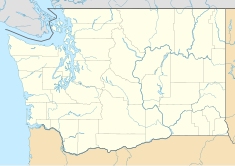Wolfenbarger Site
Wolfenbarger Site | |
| Location | Address restricted |
|---|---|
| Nearest city | Curtis, Washington |
| Coordinates | 46°35′13″N 123°06′36″W / 46.58694°N 123.11000°W |
| Area | less than one acre |
| NRHP reference No. | 77001346[1] |
| Added to NRHP | May 2, 1977 |
The Wolfenbarger Site is an archaeological site of the Kwalhioqua–Clatskanie people, as well as a noted hops farm of Herman Klaber, located near Curtis, Washington. The site has been listed on the National Register of Historic Places (NRHP) since 1977.
History
[edit]The land was once settled by the Kwalhioqua–Clatskanie people, also known as the Willapa or Willoopah. The Willapa used the area as a domestic village and for agriculture.[2]
Artifacts from the Wolfenbarger Site were proposed to be stored in a museum setting at the Boistfort High School, a neighboring NRHP listed schoolhouse, as a means to keep the school open during the late 1970s after a levy failure.[3]
Site
[edit]The address to the grounds are restricted but the site is described as located on a terraced bank of Beaver Creek approximately 2 miles (3.2 km) south of the unincorporated community of Curtis. The site is 9 m × 60 m (30 ft × 197 ft) and near the time of its addition to the NRHP, was summarized to contain trees such as Douglas fir and red cedar with some oak and alder. The land was covered in various plant species including bracken fern, Oregon grape, and salal. The underbrush was noted to have a composted layer up to 7 cm (2.8 in) thick and the alluvial soil considered advantageous for farming.[4][5]
Significance
[edit]The Wolfenbarger Site covers a period of indigenous habitation of the area between years of 1000 and 1499.[1][2] The small parcel is also acknowledged as part of the region's hops production in the Curtis-Klaber-Boistfort agricultural valley between 1920 and 1924, specifically that of prominent hops farmer, Herman Klaber. The site was noted as being "virtually undisturbed", a rarity for archaeological sites in Southwest Washington.[5][2]
The area was protected under the National Register of Historic Places on May 2, 1977.[1][6] The site is also listed with the Washington State Heritage Register.[7]
References
[edit]- ^ a b c "National Register of Historic Places Inventory/Nomination: Wolfenbarger Site". National Park Service. Retrieved November 5, 2024.
 This article incorporates text from this source, which is in the public domain.
This article incorporates text from this source, which is in the public domain.
- ^ a b c "Washington - Lewis County". National Register of Historic Places. Retrieved November 5, 2024.
- ^ "Group eyes historic site". The Daily Chronicle. August 5, 1977. p. 7. Retrieved November 5, 2024.
- ^ Prehistoric Places on the Southern Northwest Coast. Burke Museum of Natural History and Culture. 1983. p. 155. Retrieved November 5, 2024.
- ^ a b McCracken, Gordon (June 18, 1977). "Boistfort site hops on register". The Daily Chronicle. p. W3. Retrieved November 5, 2024.
- ^ "Notices - Washington - Lewis County". Federal Register (PDF) (Vol. 42, No. 109 ed.). National Archives and Records Administration. June 7, 1977. p. 29063. Retrieved November 5, 2024.
- ^ Herrera Environmental Consultants, Inc.; AHBL; CORE GIS. "SHORELINE INVENTORY AND CHARACTERIZATION REPORT" (PDF). Lewis County Community Development. p. 64. Retrieved November 5, 2024.




